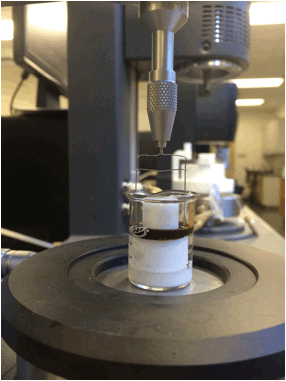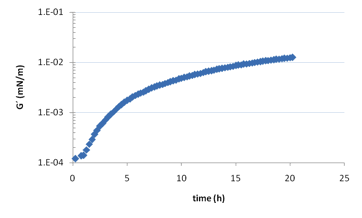Reports: ND552848-ND5: Interfacial Viscoelasticity of Crude Oils: The Role of Asphaltenes
Gerald G. Fuller, Stanford University
The aim of this research program is to investigate the role of interfacial rheology between water and heavy oil products on various processes connected to the recovery and production of oil. Of particular interest is the influence of interfacial viscoelasticity on the transport of oil droplets through porous media. Recent reports have indicated that enhancement of the elasticity of oil/water interfaces helps to resist "pinch-off" and size reduction of oil droplets as they execute their way through repeated contraction and expansion events associated with porous media flow [1]. Enhancing this resistance leads to more efficient oil recovery during water flooding operations. However, the condition of the water and its salinity, in particular, has been reported to strongly affect the development of surface rheology and our effort during this first year has been to examine this phenomena. For this purpose, we have developed a collaboration with the Reservoir Engineering Research Institute of Palo Alto, CA headed by Dr. Abbas Firoozabadi, which has access to a range of interesting heavy oil samples from strategic parts of the world.
Development of Interfacial Shear and Dilatational Rheometer Platforms
The laboratory of Professor Fuller has developed instruments both for the measurement of interfacial rheometric functions in shear [2] and in dilatation [3]. Measurements of shear interfacial rheology on crude oil/water interfaces were conducted using a variation of the successful "double wall ring" rheometer that allows one to convert a standard rotational rheometer used for bulk rheological measurements into an interfacial rheometer. In its normal configuration, however, the opaqueness of a stratified crude oil/water system presents difficulties and the simple design shown in Figure 1 was developed so that the du Nouy ring, which is used to produce shearing of the interface, can be visualized.
Interfacial dilatational measurements will be acquired using an apparatus developed in the Fuller laboratory where the shape and internal pressure of an oil drop suspended within water can be measured as the drop is inflated and deflated [3]. Although dilatational measurements have not yet been performed on crude oil/water interfaces, the equipment has been modified to accommodate crude oil systems during the present year.
Figure 1. The Double Wall Ring Interfacial Rheometer for opaque oil/water systems.
Porous Media Flow Platform
To test the influence of interfacial rheology on porous media flow, microfluidic cells consisting of patterns of interconnected channels and fluid pockets have been developed. This pressure-driven flow chamber is mounted onto a video camera-equipped microscope so that the transport of an oil phase being pushed by a water phase can be imaged as a function of space and time. Of particular interest are droplet pinch-off events, and ultimately the efficiency of oil recovery is determined by measuring the amount of oil that remains within the porous media chamber after water displacement.
Results
Table 1 shows the interfacial elastic shear modulus, G', that was measured at the crude oil/water interface as the NaCl concentration of the water was varied. The crude oil sample, referred to as BAB, was obtained from an oil field in Abu Dhabi and is known to develop problems with asphaltene depositions.
Table 1: Interfacial Shear Elastic Moduli as a Function of Salinity
NaCl concentration (wt%) |
Interfacial Shear Elastic Modulus (mN/m) |
0 |
0.008 |
0.1 |
0.025 |
1.0 |
0.0134 |
10.0 |
0.0098 |
It is notable that the surface elasticity of the crude oil/water interface is a function of salt concentration and this property goes through a maximum at 0.1%. Furthermore, the kinetics of interfacial viscoelastic formation is very slow, as evidenced in the graph of surface elasticity as a function of time in Figure 2 for a salt concentration of 1%.
Figure 2. The evolution of the interfacial elastic modulus of the BAB crude oil/water interface at a salinity concentration of 1%.
Investigations of the consequences of salt concentration on the transport of oil though porous media by being "pushed" by water have been performed using the microfluidic, pressure-driven flow chambers discussed above. Figure 3 is series of images where oil is being forced from the porous structure of the microfluidic device through application of a flow of water of different NaCl salinities of 1μl/min. The concentration of NaCl is seen to have a clear effect on the manner by which the oil is displaced. This series of images shows that the water front is able penetrate deepest into orthogonal bifurcations at a salinity 0.1%wt NaCl.
Figure 3. Photomicrographs of oil (darker phase) being displaced by water (brighter phase) of various salinities. Note that the penetration of the water at a NaCl concentration of 0.1% wt is the largest.
Research Planned in Year Two
In the coming year, the work on the rheology of crude oil/water interfaces will be expanded to include dilatational rheology. Dilatational deformations are particularly important to the dynamics of film drainage as water and oil droplets are pressed against one another. Consequently, the development of dilatational elastic moduli can strongly inhibit coalescence, which will affect oil recovery in EOR operations. In addition, an additional apparatus is being constructed to directly examine film drainage at the complex interfaces that develop in crudes laden with asphaltenes. This apparatus will be a variant of a previously develop instrument in the Fuller laboratory [4].
References
Alvarado V, Bidhendi MM, Garcia-Olvera G, Morin B, Oakey JS, Interfacial Viscoelasticity of Crude Oil-Brine: An Alternative EOR Mechanism in Smart Waterflooding, SPE-169127-MS, 2014.
2. Vandebril S, Franck A, Fuller GG, Moldenaers P, Vermant J, A Double Wall-Ring Geometry for Interfacial Shear Rheometry, Rheologica Acta, 49(2009)131.
3. H. Xu, S. Melle, K. Golemanov, G. Fuller, "Shape and Buckling Transitions in Solid-Stabilized Drops", Langmuir, 2005,
4. Stancik EJ, Fuller GG, Connect the drops: Using solids as adhesives for liquids, Langmuir, 20(2004)4805.














